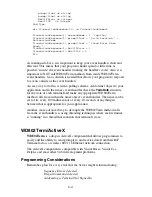
4-2
covers, you won't have a problem. If you find a spot that none of the
planned Access Point locations will cover, you will have to move one of the
Access Points closer to the problem spot or plan on adding another closer
Access Point. It is best to locate the Access Point in the center as high as
possible of the area you intend coverage. The weakest signal will be directly
under an access point, (if the antenna is vertical).
Avoid locating antennas close to large metal objects such as filing cabinets,
microwave ovens, 2.4GHz cordless phones, or large containers of water.
Avoid placing antennas close to an outside wall to minimize signal
efficiency. If you need to have coverage outside, place it next to a window.
Once you have determined the Access Points and their locations, you are
ready to wire the Access Points to the LAN.
To perform a Site Test, turn the unit on and press any key to go past the
opening screen and get to the "Mode Menu" which displays as follows:
DEVICE SIGN ON ----->1
SETUP MODE----------->2
SITE SURVEY----------->3
Press the
3 key to start the Site Survey.
The terminal will do an Access Point Scan and report on the three Access Points
with the strongest signals contacted, (or fewer than three is less contacted). The
display will be updated every two seconds and have the following format:
ACCESS POINT SCAN
---SSID--- CHAN SIGNAL
WORTH DATA 11
80%
WORTH DATA 9 65%
WORTH DATA 5 35%
HIT F1 TO EXIT
Access points without a matching SSID will not be shown, unless the
Terminal's SSDI is blank. If no Access Point can be located, nothing will show
below the headings.
The "SIGNAL" number on the right that can vary from 0-100, with 100
being best. You have adequate signal strength at 20. If you have less than
20, you need to move or add an Access Point. Typically it operates in the
50% range. (50% is not bad; the radios on the Access Points and the
Terminals drop power to conserve batteries and to minimize interference).
Remember when doing a site test in a warehouse, as the contents of the
warehouse change the interference changes too. So if you have a marginal
signal on the Site Survey, it may turn into poor performance later.
There is also some basic information about Radio Frequency itself that can help
you make smart choices about the location and composition of your system:
•
Metal walls are almost impenetrable by RF. If your warehouse
















































